Psych 389 exam 3 lecture and textbook notes
1/277
There's no tags or description
Looks like no tags are added yet.
Name | Mastery | Learn | Test | Matching | Spaced |
|---|
No study sessions yet.
278 Terms
adversarial system
A system of resolving disputes in which the parties, usually represented by counsel, argue and present evidence to a neutral fact finder, who makes a decision based on the evidence and arguments presented by the parties; as distinguished from an inquisitorial system, in which the fact finder takes an active part in determining what occurred.
inquisitorial approach
contrasts with the adversarial system
-used in Europe (but not in Great Britain, the legal system in which the judge plays a very active role in determining the accuracy of evidence before the court (as contrasted with the adversarial approach, in which the judge is a more passive evaluator of evidence presented in a trial).
black letter law
(sometimes referred to as the law on the books), basic principles of law generally accepted by courts and embodied in statutes.
-According to the black-letter law, Lester Zygmanik was guilty. But there is another way to judge his actions—by focusing on his altruistic motives and his desire to help his brother, rather than to harm him
euthanasia
the act of killing an individual for reasons that are considered merciful
highlights the inconsistency between legality and people's perceptions of what is moral, ethical, and just
intention
The offender's frame of mind in committing a criminal act.
attribution theory
A theory in social psychology focusing on people's explanations for the causes of their behavior and the behavior of others.
tends to vary along three dimensions: internality—whether we explain the cause of an event as due to something internal to a person or to something that exists in the environment; stability— whether we see the cause of a behavior as enduring or merely temporary; and globalness —whether we see the cause as specific to a limited situation or applicable to all situations.
distributive justice
Concerns about what is right or just with respect to the allocation of goods within a society. A person will be more accepting of decisions and more likely to believe that disputes have been resolved appropriately if the outcomes seem just (or if the outcomes—in the same sense as salaries or promotions—seem distributed equitably)
Procedural justice
suggest that if individuals view the procedures of dispute resolution or decision-making as fair, then they will view the outcome as just, regardless of whether it favors them or not.
commonsense justice
—ordinary citizens' basic notions of what is just and fair
- reflected in cases in which a jury refuses to convict a defendant who is legally guilty of the crime charged— the phenomenon known as jury nullification, in contrast to the dictates of formal, statutory law.
Diversion
The practice of officially stopping or suspending a case prior to court adjudication (without a formal trial) and referring the defendant to a community education, treatment, or work program in lieu of adjudication or incarceration.
extralegal factors
Influences that are legally irrelevant in that they cannot serve as evidence in a legal proceeding (e.g., age, race, gender, and socioeconomic status).
Legal formalism
The model holding (in contrast to legal realism) that legal decision makers dispassionately consider the relevant laws, precedents, and constitutional principles, and that personal bias has no part in decision-making.
legal realism
The model holding (in contrast to legal formalism) that judges view the facts of cases in light of their attitudes and values, and make decisions accordingly.
in-group bias
The tendency to favor one's own group over other groups
intuitive processes
Incidents of spontaneous mental processing that are often acted on but not given careful thought or effort, also known as system 1 processing
deliberative processes
that involve mental effort, concentration, motivation, and the application of learned rules, also known as system 2 processing
self-determination theory of optimal motivation
Theory describing situational and personality factors that cause positive and negative motivation and, eventually, changes in subjective well-being.
intrinsic motivation
engaging in an activity because it is interesting and enjoyable (internal factors) rather than external factors
extrinsic motivation
pursuing goals that would please and impress others
- In other words, they felt less self-determined at the end of the year than they had at the beginning.
probabilistic estimates
Predictions about outcomes, made far in advance of the known outcome.
- When lawyers decide whether to take on a new client or a new case, they have to make predictions (probabilistic estimates) about case outcomes months and years in advance of those outcomes
illusion of control
lawyers may discount the strengths of their adversaries, the whims of the judge, and their own weaknesses, and make predictions of personal success than are higher that may be warranted by reality
bench trial
judge determines the verdict, not the jury
What is the difference between the adversarial and inquisitorial models of trials?
The trial process in the United States and several other countries is called the adversarial model because all the witnesses, evidence, and exhibits are presented by one side or the other. In contrast, in the inquisitorial model used in much of Europe, the judge does nearly all questioning of witnesses. Although the adversarial model has been criticized for instigating undesirable competition between sides, in empirical studies it has been judged to be fairer and to lead to less-biased decisions
How do notions of morality and legality differ?
What is considered moral is not always what is ruled legal, and vice versa. When determining right and wrong, some people rely on the law almost entirely, but many people have internalized principles of morality that may be inconsistent with the laws
How do different models of justice explain people's level of satisfaction with the legal system?
According to the distributive justice model, people's acceptance of a legal decision is related to whether they think the outcome, or decision, is fair. According to the procedural justice model, fairness in the procedures is a more important determinant of satisfaction. When people think they were treated fairly, they are more accepting of legal outcomes
What is commonsense justice?
Commonsense justice reflects the basic notions of everyday citizens about what is just and fair. In contrast to black-letter law, commonsense justice emphasizes the overall context in which an act occurs, the subjective intent of the person committing the act, and a desire to make the legal consequences of the act proportionate to the perceived culpability of the actor
How are judges selected and how do their demographic characteristics and attitudes influence their decisions?
Federal judges are appointed for life. Most state court judges are appointed and then run on their records in retention elections. Judges' demographic characteristics tend not to influence their decisions, probably because the experiences of law school and years of work as a lawyer are powerful socializing forces. On the other hand, judges' biases and predispositions do tend to influence their judgments
How does the experience of law school affect its students?
Attending law school tends to under- mine students' values, motivation, and psycho- logical health because it reduces their intrinsic motivation and sense of self-determination
What is known about lawyers' professional satisfaction?
Although most lawyers think their work is stimulating, fewer would recommend that others pursue a career in the law. Lawyers who do not have typical "lawyer traits" of competitiveness and achievement orientation are less satisfied than those who do
What factors explain lawyers' overconfidence and how can it be remedied?
Lawyers, particularly trial lawyers, are overconfident about their chances of future success because they rarely get useful feedback about their decisions and often assume that they can control case outcomes. Discussing a case with just one other attorney can lead to more accurate predictions about future results
jury sentiments
Beliefs, opinions, and views of jurors that are unrelated to the evidence and the law in a trial.
- play a role in decision making when jurors believe that the "crime" is just too trivial for any punishment or at least for the expected punishment, and find the defendant not guilty to ensure that he or she will not be punished
selection effects
A bias that occurs when random assignment is not achieved in a research study and results can be attributed to the selection of respondents. Because defense lawyers expected juries to be biased in favor of plaintiffs, they tended to settle cases in which the plaintiff had a strong case. That meant that on average, juries were left to decide relatively weaker cases for the plaintiff and appeared to make different decisions than judges. But taking selection effects into account, judges and juries may not actually be so different
venire
jury selection begins before potential jurors arrive at the courthouse, as officials assemble a panel of prospective jurors
cognizable groups
members of which, because of certain shared characteristics, might also hold unique perspectives on selected issues
PRE-1960s CASE LAW
BROWN v. MISSISSIPPI (1936)
SUBJECTIVE STANDARD
OBJECTIVE STANDARD
Escebedo v. Illinois (1964)
Miranda v. Arizona (1966)
BROWN v. MISSISSIPPI (1936)
Confession considered coerced if it "shocked the conscience" of the reasonable person
SUBJECTIVE STANDARD
A rule that appeals to one's personal definitions, emotions, moral reactions
OBJECTIVE STANDARD
A rule that focuses on objective circumstances of the case
Escebedo v. Illinois (1964)
if ask for attorney, one must be provided
Miranda v. Arizona (1966)
must be informed of rights, given an attorney if asks. IF NOT, CONFESSION CONSIDERED COERCED
Inbau and Reid
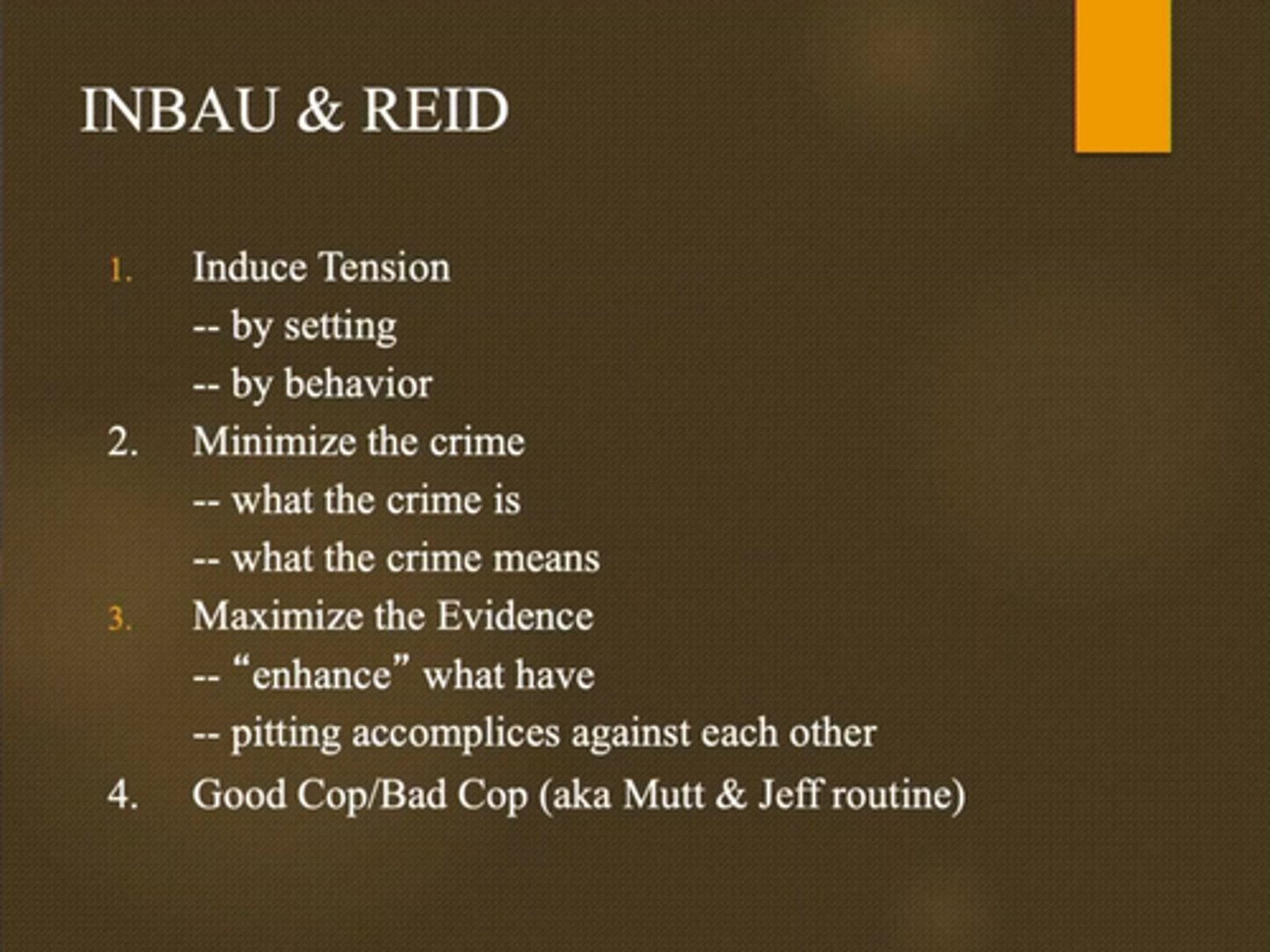
Kassin et al. (2003)

Kassin & Kiechel (1996)
False confessions: had students type fast on a computer but not to press the ALT key if they did it would crash losing important info. The computer automatically crashed and 69% said they had pressed the ALT key though they had not, 28% were convinced they actually had
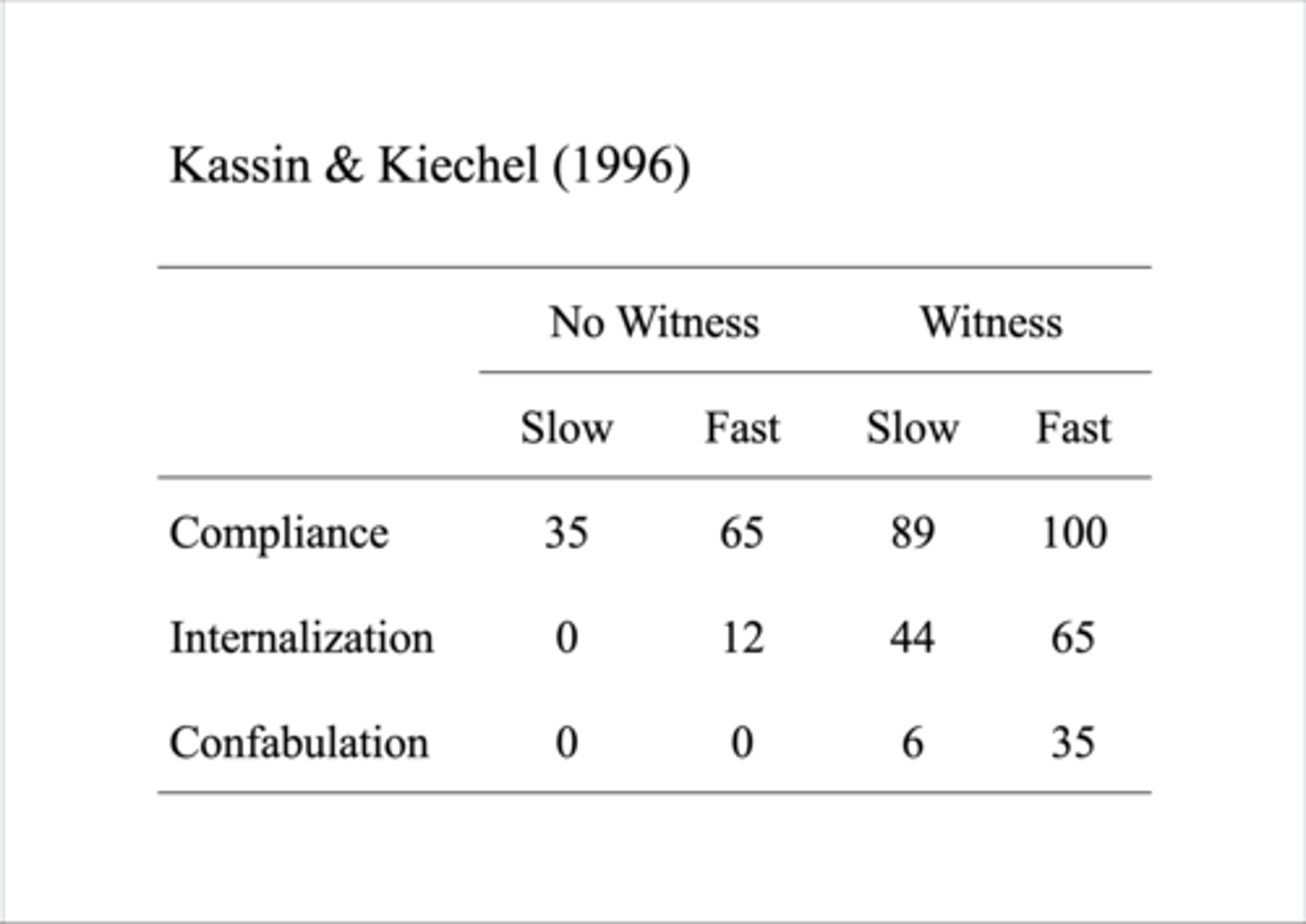
Recommendations
-Look for factors suggesting coercion or pliability (conditions of interrogation, age, & competency of suspect)
-Check if confession is consistent; does it match the facts of the case.
-Consider whether the suspect is revealing information only the perpetrator would know
Videotape the interrogation
FUNDAMENTAL ATTRIBUTION ERROR (Correspondence bias)
People overweight personal factors in their predictions, attributions, and explanations about other people's behavior and underweight the power of the situation
Scott v harris
A police officer's attempt to terminate a dangerous high-speed car chase that threatens the lives of innocent bystanders does not violate the fourth amendment, even when it places the fleeing motorist at risk of serious injury or death.
Kassin & Wrightsman (1980)
Read case with confession:
% Guilty
Free Confession 78%
Pos. Inducement 50%
Neg. Inducement 22%
No Confession 11%
JURY SELECTION: PROCEDURE
Venire:
Voir Dire
Venire:
: constructing panel of potential jurors
-- random sampling of voters/telephones/utilities
-- "key person" approach
Voir Dire
attorneys interview jurors, can accept or exclude
-- exclude for cause
-- peremptory (no justification needed)
U.S. News & World Report (1995)
JURY VERDICTS:
"always be based on largely on personal prejudices"
AGREE: 48%
DISAGREE: 45%
Scientific Jury Selection Techniques
SURVEY COMMUNITY
PERSONALITY/ATTITUDE TESTS
WATCH FOR NONVERBALS
**Get more systematic. Use scientific jury selection. Have behavioral scientists like me. Ideally, would like to interview jurors beforehand, give them a summary of the case, and see where they lean. But can't. Why not? So how do it? Survey community, give them summary, establish a demographic profile of more favorable and least favorable jury.
Give personality tests (authoritarianism); watch for non-verbals.
Does it work? Think so, OJ Simpson (Jo-Ellan Demetrius; guy in the back). First few cases tried, full blown, cause-celebre cases in early 70s. Berrigan brothers, accused of conspiracy to impede draft, blow up tunnels in DC. Defense won; 6 other cases like this. Good enough? No, full blown cases, everyone pulling out all stops, might have won anyway.
Look at more systematically. Many ways to do this. Divvy people into pro-prosecution, defense people and see how impactful these opinions and biases were. But better yet, good to compare with something else ... how big compared against what should matter--the evidence
SURVEY COMMUNITY
to get demographic profile of the most sympathetic type of jurors
PERSONALITY/ATTITUDE TESTS
see if person gives responses that tend to be pro-prosecution or defense (authoritarianism)
WATCH FOR NONVERBALS
observe juror demeanor during the voir dire
cultural cognition
refers to the tendency to conform one'sbeliefs about putatively dangerous forms of behavior toone's cultural evaluations of them.• In essence, risks seen as greater if the behavior violatesone's ideological leanings• Guns are not seen as risky by conservatives• HPV vaccination is not seen as risky by liberals
Anwar et al. (2012)
black people are more likely to be convicted if there are no black people in the jury pool
Ostrom, Saks, & Werner (1978)
Culled 175 case summaries from appellate sources
Separated Weak from Strong Cases
Gave Subjects 1, 3, or 6 Major Pieces of Evidence
Split Subjects into Pro- and Anti-Prosecution
Baston vs. Kentucky
Landmark decision of the US Supreme Court ruling that aprosecutor's use of peremptory challenges in a criminalcase—the dismissal of jurors without stating a validcause for doing so—may not be used to exclude jurorsbased solely on their race.
Do Attitudes Matter?
Yes, but minor. Certainly there, but not big. Other work confirms this: authoritarism, a hi person is about 54% likely to convict versus 46% for low. Not big at individual level. Would be big if could get uniform jury, but hard to do. Evidence matters, and is uniform for all the jury. Adding an eyewitness ...
Need to pay attention to the evidence, in fact, evidence is so important, doesn't even need to change to make a losing case a winner; can change it by how it's presented.
To know how, need to know how juries tend to approach a task. Have to form a story, with a beginning, middle, and end. Usually, defense and prosecution providing a story, but may be hard to distill out. So many witnesses.
Suppose you have this story: guys in bar, hitting, fight, go home, go to another bar, another fight. But how are witnesses called? What if you took witnesses and placed them from the beginning to the end?

Pennington & Hastie (1988)
Evidence matters a great deal. That's the good news. Smart lawyers focusgroup their evidence.
What about the jury room? Simple, imperfect, but simple story. Depends on what a majority of jurors think walking into deliberation room. Discussion tends to reconfirm what the average sense of the room was going in
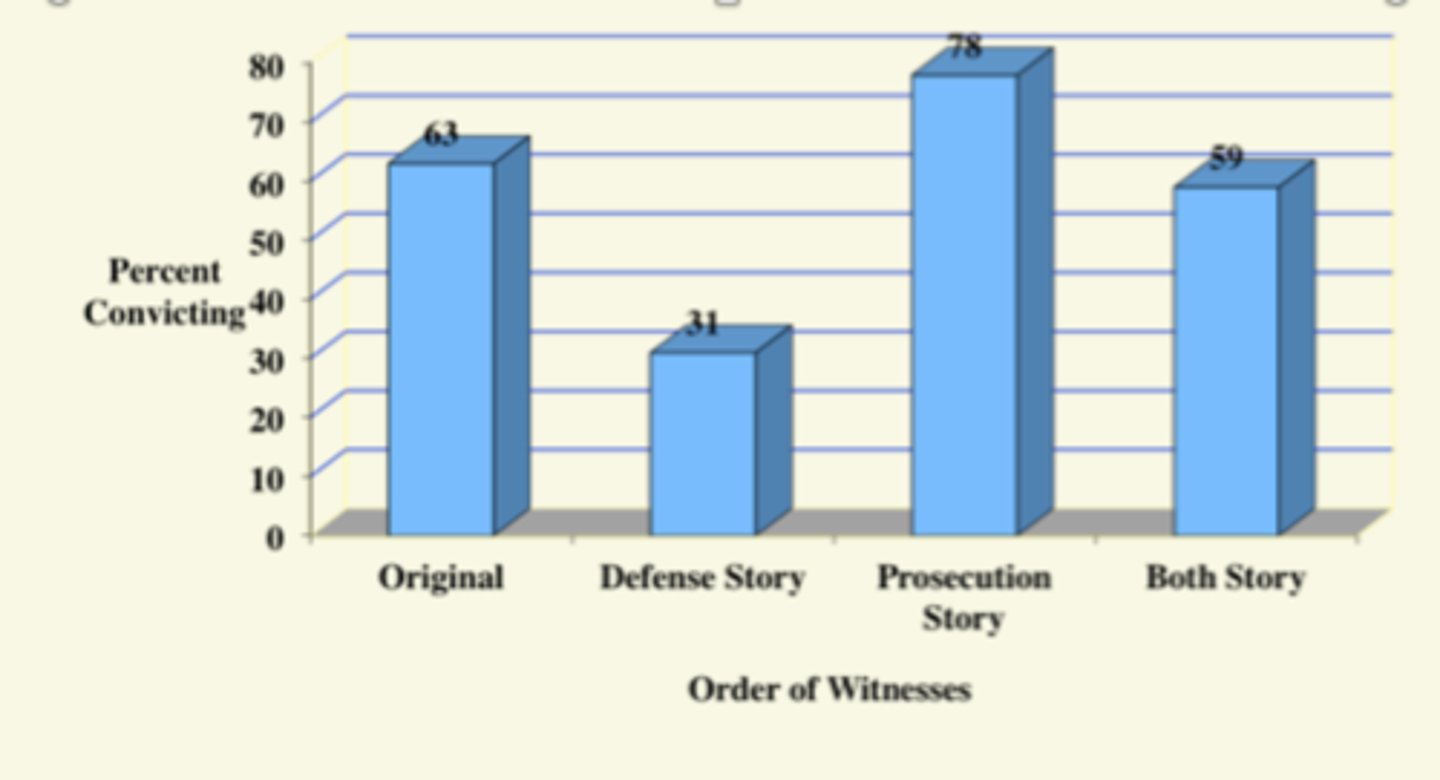
Myers & Kaplan (1976)
Shown by Myers and Kaplan. Gave students cases to read. One left people with an impression of guilt; one of innocence. Half the people asked to discuss the evidence and their verdict in a group. Tendency tends to exacerbate.
Looked at with hundreds of studies, manipulating what the sense is in the room. Get this group polarization, with a modification.
-showed strong cases of the defense or weak cases of the evidence of the defense
Weak-towards innocence
Strong- towards guilty
Group polarization: group discuss your opinion and people are more polarized to the opinion of the majority of the group

Devine et al. (2001)
If majority are for conviction, that's what you get. But it must be a clear majority. Around the middle, get hanging.
But, not all that a juror hears is official evidence. Kobe Bryant case. We are hearing a lot, imagine what's going on in Eagle, CO. Lots of info about alleged victim, past behavior of Bryant ... not relevant. This can happen before trial, it can happen during trial as well--inadmissible evidence. The forbidden fruits of evidence.
How do jurors deal with this? In the case of pretrial publicity, asked if can set aside. For inadmissible evidence, told not to pay attention. But can? Can bringing something up and telling you to ignore possible? Like if told you not to think of a white bear ... now don't....
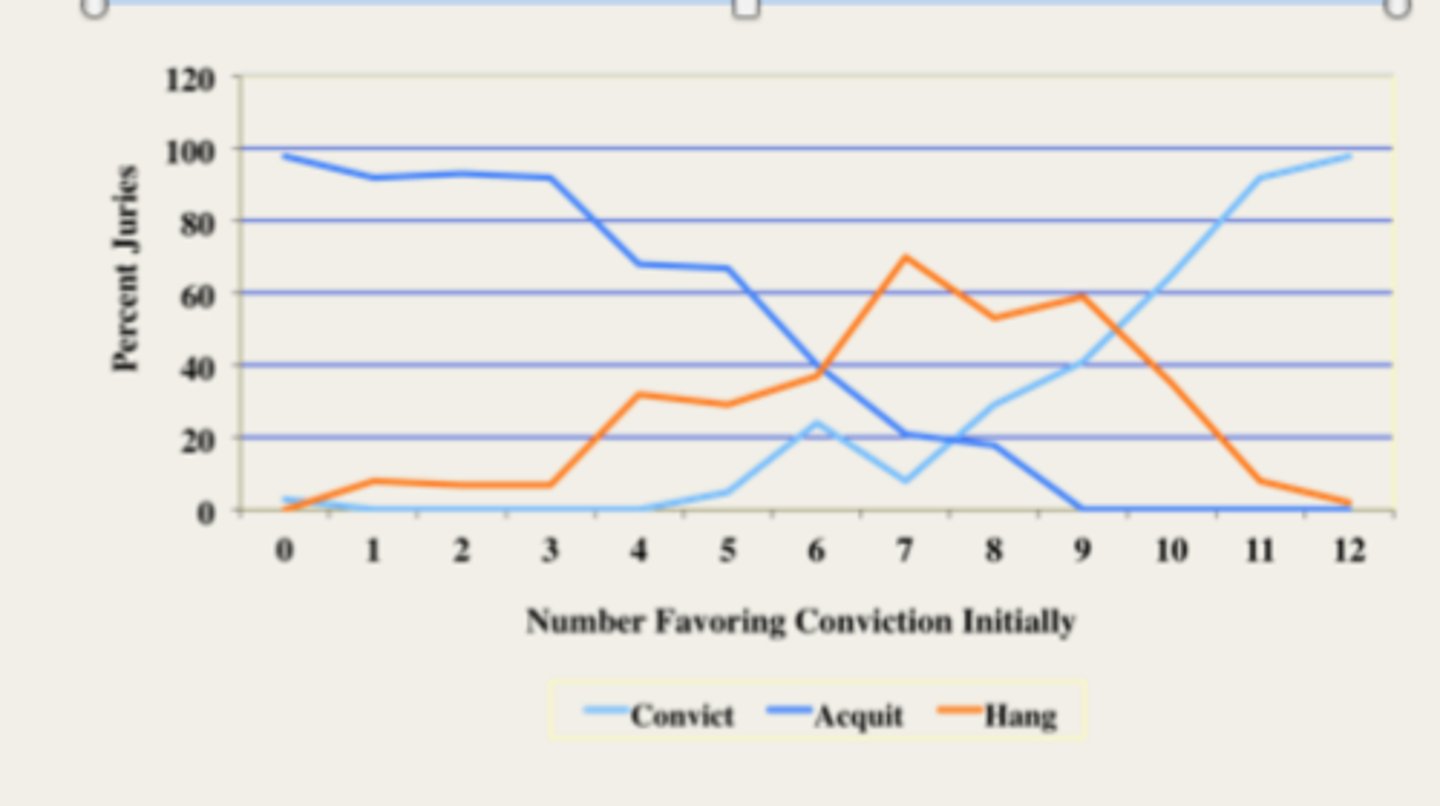
ON PRE-TRIAL PUBLICITY
SUPREME COURT CASE LAW:
IRWIN v. DOWD (1961)
IRWIN v. DOWD (1961)
--"due process violated if potential jurors are familiar
with the case and have formed opinions."
--If this has occurred, then a change of venue is
granted.
HOWEVER:
-- prior information must be considered PREJUDICIAL
-- potential juror not considered biased if states that he/she can lay aside prior information and opinion and render a verdict based on evidence presented in court.
Ross, Lepper, & Hubbard (1975)
General case- people hooked up a psychological machine
There is a significant differences between the group that think they are going to succeed and the ones that are going to fail
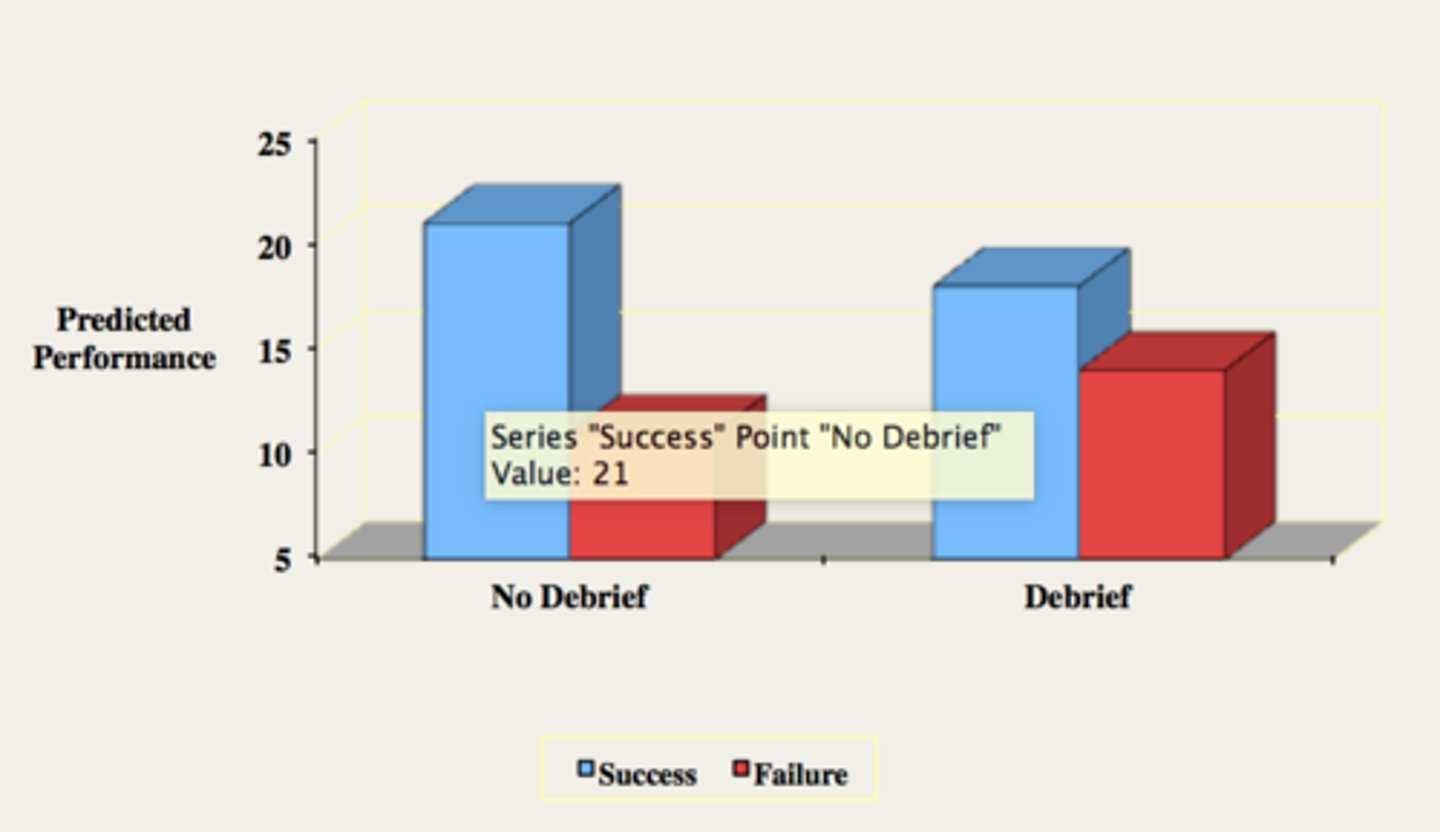
Sue, Smith, & Caldwell (1973)
Sue ... liquor store robbery. Someone in the neighborhood arrested. Wiretap.
Instructions to ignore sometimes work, usually have no difference, can even backfire.
Presented with written transcript of a trial that are being convicted of burglary
The wiretap evidence was presented but there was no warrant that they could wiretap and it was illegal, people pay attention to evidence, but admissible evidence as well
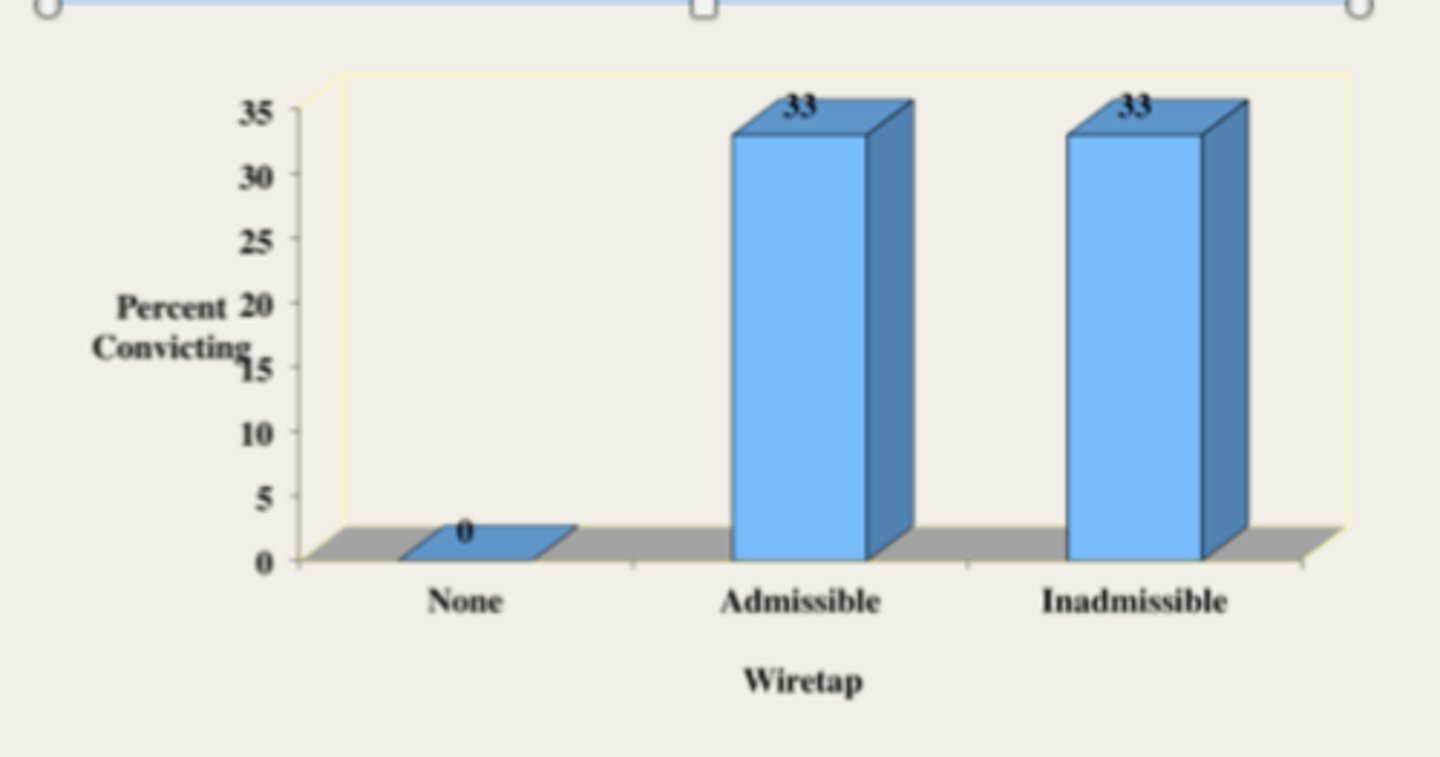
Fein, McCloskey, & Tomlinson (1997)
But what does work? Fein (see details).
Not pleading, not a legal rationale, calling the motives and fairness of the other party into question. Known in persuasion work, the ulterior or fairness motives of others are important.
Now, that's one challenge ... and it's a classic one. A newer one is the introduction of scientific expert testimony. Eyewitness, DNA,CSI stuff. How well can jurors handle it?
Looked at situation where someone was on trial for stabbing someone at a liquor store: person said it was self-defense,
2nd condition: special evidence was introduced, a customer has seen that mr zed had lunged at the victim with the glass, as eyewitness you can only say what they saw, they have to report it themselves instead of what they heard in an interview = went up to 58%
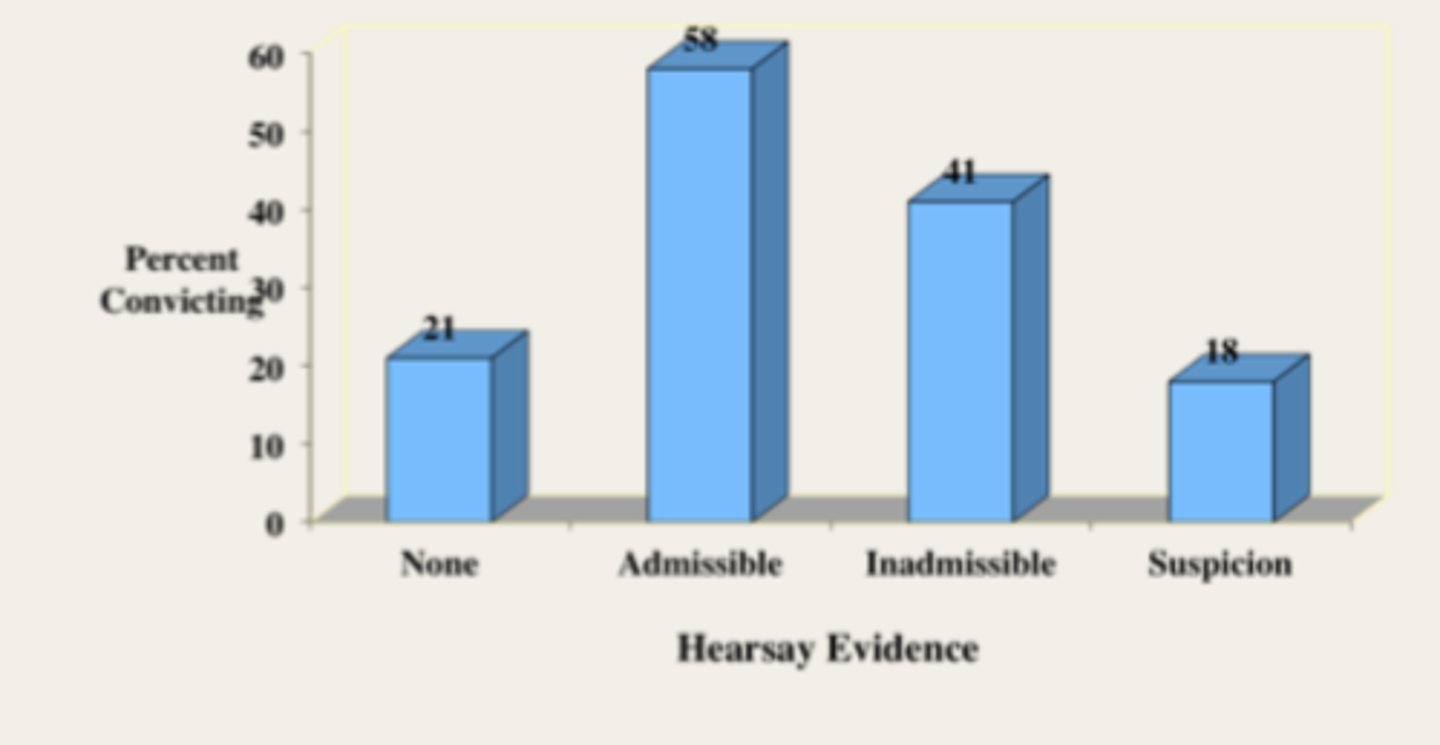
Kamin & Rachlinski (1995)
Effect of hindsight bias on people's judgments of liability.
Condition Should have hired Bridge Operator?
Foresight 24%
Hindsight 57% (negligent)
Hindsight/Debiased 56% (negligent)
***Treat well, get a suspended sentence
Poorly, max sentence...
City gets sewed for not having the monitors when they did not seen to need them
2nd: they are now a juror, they have to decided if deluge is negligent in not having a bridge operator:
Judge the person as they were that day and what decision they would have made
voir dire
to see what is said
- The forum in which the judge and/or the attorneys question prospective jurors
social desirability effect
Most people want to present themselves in a positive, socially desirable way. This desire to appear favorably, especially in the presence of a high-status person such as a judge, shapes how people answer questions and influences what they dis- close about themselves
challenges for cause
In any trial, each side can claim that particular jurors should be excluded because they are inflexibly biased or prejudiced or because they have a relation- ship to the parties or the issues that creates an appearance of bias
peremptory challenge
Each side may also exclude a designated number of prospective jurors "without a reason stated, without inquiry, and without being subject to the court's control"
social judgments
People infrequently admit (even to themselves) that social category information such as race influences their decisions often because they want to appear to be unprejudiced and to avoid the social consequences of showing racial bias
implicit personality theory
is a person's organized network of preconceptions about how certain attributes are related to one another and to behavior
- lead to stereotypes, when a person believes that all members of a distinguishable group (e.g., a religious, racial, sexual, age, or occupational group) have the same attributes
similarity leniency hypothesis
Another common attorney strategy is based on the assumption that jurors who are demographically or socially similar to a litigant will be predisposed to favor that litigant
black sheep effect
Although people generally favor individuals who are part of their in-group, they may sometimes strongly sanction those fellow members who reflect negatively on and embarrass the in-group
Authoritarianism
one personality characteristic of jurors that is modestly correlated with their ver- dicts in criminal cases
-adhere rigidly to traditional values, identify with and submit to powerful figures, and are punitive toward those who violate established norms
- are more likely to vote for conviction in mock jury experiments
Need for Cognition
refers to a person's inclination to engage in and enjoy effortful cognitive work
- explains why some people are motivated to think hard and analyze arguments thoroughly, and others are disinclined to do so.
Five-Factor Model of personality
a generally accepted framework for describing personality characteristics
- The traits that form the model are (1) Openness to Experience, (2) Neuroticism, (3) Extraversion, (4) Conscientiousness, and (5) Agreeableness
-According to this model, one's personality can be described by some combination of these traits.
scientific jury selection
These consultants use empirically based procedures, such as small-group discussions called focus groups, shadow juries, systematic ratings of prospective jurors, and surveys of the community, to identify desirable and undesirable jurors
evaluation apprehension
whereby they provide the answers that they perceive the judge wants to hear, regardless of whether their responses are truthful
source monitoring error
jurors are mistaken about the source of their information
specific pretrial publicity
showing that case- specific information made available prior to trial can affect the sentiments of jurors in that trial
generic prejudice
that is, prejudice arising from media coverage of issues not specifically related to a particular case but thematically relevant to the issues at hand
change of venue
the trial is conducted in a different geographic jurisdiction and that jurors for the trial may be drawn from this new juris- diction. But venue changes are expensive, inconvenient, and time-consuming, so judges are reluctant to grant them, though some evidence suggests that they are more easily persuaded when defense attorneys provide media analyses documenting the extent of news coverage
-can result in significant variations in characteristics of the communities involved
Symbolic Functions of Jury (Tribe, 1972)
Juries are to render accurate judgments, but beyond that...
Respect for individuals
Respect for democracy
Respect for liberty
Respect for individuals
(assume innocence)
Respect for democracy
(decisions are made by jury, not the state)
Respect for liberty
(it is a worse mistake to convict an innocent person than to free a guilty one)
ADMISSIBILITY OF EXPERT TESTIMONY
U.S. V. AMERAL (1973): An expert must have "special knowledge, experience, skill, or training not ordinarily found in lay jurors."
-Subject matter beyond the common understanding of the jury
-Expert is well-qualified
-Evidence is scientifically reliable (Frye or Daubert test)
-Probative value of testimony outweighs its prejudicial value
ISSUES (Tribe, 1972)
-How Spot Charlatans?
-Scientific evidence will be overweighed (prejudicial) because of its prestige
-Scientific evidence will be overweighed because of its precision
-Scientific evidence is probabilistic (based on long run averages over groups of people); whereas our legal system is based on the notion of particular evidence (evidence about the particular case at hand)
A STATISTICAL ANALYSIS
Man
OVER 6'2'' 1/10
BEARD 1/10
MOUSTACHE 1/10
Woman
BLONDE 1/3
PONYTAIL 1/10
Car
YELLOW 1/10
Seeing these
characters in car 1/1000
A Hypothetical Example
Detective's Prior Belief: 10% likely to be guilty
Then, Blood Test:
Defendant shares same rare blood type as the unknown perpetrator. This type only occurs in 1% of population.
Question:
Now after blood evidence, what should detective's estimate that the defendant is guilty be?
10% 20% 30% 40% 50% 60% 70% 80% 90% 100%
Now, of those not guilty, how many will test positive?
Guilty Not Guilty
Blood + 100
Blood - 0
100 900 1000
-9 will
A NOTE ON PROBABLISTIC EVIDENCE (v. Particular)
Law wants particular evidence, but science doesn't provide it.
1. Scientific conclusions are not certain
2. Based on data other than the case at hand
Reject Scientific Evidence?
You could, but...
1. Rejecting evidence and the theories it supports is really to adopt a "null" theory.
2. Probabilistic evidence can often be portrayed as particular, so what's the difference?
3. If use theories of human nature to decide cases, don't you want the one that's been tested and affirmed?
ALTERNATIVE DISPUTE RESOLUTION
Less formal, expensive substitutes for trial litigation
Mediator
Arbitration
Judicial Settlement Conference
Summary Jury Trial
Mediator:
third-party tries to work things out between disputants.
Arbitration:
both sides present case to panel of retired judges, who decide on resolution